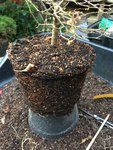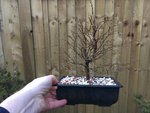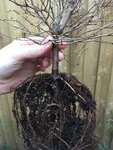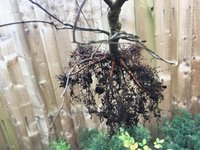You are using an out of date browser. It may not display this or other websites correctly.
You should upgrade or use an alternative browser.
You should upgrade or use an alternative browser.
Zelkova ground layers
- Thread starter keri-wms
- Start date
leatherback
The Treedeemer
Nice succes!
Thanks! There’s a gap in the nebari round the back but I hope it’ll add more roots from the calous...Nice succes!
sorce
Nonsense Rascal
Started in the pot?
Nice.
Sorce
Nice.
Sorce
I had a few starter / semi trained broom Zelkova like this, I realised all of them had tangled tap root bases, so I up-potted them from their bonsai pots to big plant pots and ring barked/hormone powdered them. In most cases the twisty bases survived so I’ll turn them into bonus Mame Neagari with luck!
CWTurner
Omono
Ground layers? Huh?
CW
CW
AaronThomas
Omono
Looks great!
Curious... is there a higher success rate with ringing and hormone use in a ground layer verses simply using a tourniquet? Especially in an elm?
Curious... is there a higher success rate with ringing and hormone use in a ground layer verses simply using a tourniquet? Especially in an elm?
River's Edge
Masterpiece
Actually there is no reason why the two techniques cannot be combined to achieve the benefits of both. The wire adds assurance of preventing bridging and also encourages more flare and build up at the base prior to root formation. During the callus stage.Looks great!
Curious... is there a higher success rate with ringing and hormone use in a ground layer verses simply using a tourniquet? Especially in an elm?
AaronThomas
Omono
Interesting... thank you.two techniques cannot be combined
I’ve had success with just the tourniquet method in an elm with the help of Leatherback last season.... was curious about cutting.
MrWunderful
Omono
I have found the exact same results, I use tourniquet because its far faster and more efficient.Interesting... thank you.
I’ve had success with just the tourniquet method in an elm with the help of Leatherback last season.... was curious about cutting.
AaronThomas
Omono
That’s what I have understood as well…more efficient
AaronThomas
Omono
I don’t think it is as ugly as you are perceiving it to be.Here’s the ugly
Chances are you’ll get more root growth in that area… And overtime as the current roots thicken up I think the space will slowly disappear.
MrWunderful
Omono
That’s what I have understood as well…
If I was only doing one, or a quality tree, I would do both.
I did 100 or so seedlings, and throwing a washer on the smalls and a few wraps of wire on larger seedlings was waaayy faster then cutting rings, making sure the bridge is gapped, hormone etc.
I feel OP got pretty decent results, about half the elms I layer dont get 100% radial root spread. Its just the luck of the draw.
You can always cut a window/graft later if it doesnt fill in.
I first tried this technique on a volunteer American Elm seedling I had found growing in the yard. After a year or two of working on the root base, I transplanted it to a sunny growing ground and planted it on a ceramic tile. Three or four years later, it was about 20 feet tall. Since it cost me nothing, I added a tourniquet using a radiator hose clamp to ground layer a new set of roots and dug it the next year. Worked much better than expected, with 360 degrees of roots all along the same line. Used a reciprocating saw to cut the original roots off and it didn't miss a beat.

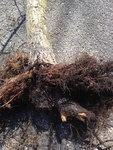
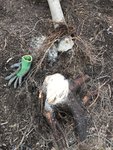


Last year I tried a similar technique on couple of zelkovas I was growing in the ground with 3-4" trunks. This time I did the ring method by stripping the bark, added root hormone, packed with sphagnum, covered with mulch, and dug them a couple of weeks ago. On one, I only had a couple of spots where I got new roots so I just kept the original roots (probably because the mulch layer got eroded and the layer area was exposed to the elements).
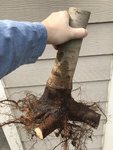
Second I had much better success with a ring of fine roots around about 80% of the trunk. Used the reciprocating saw to saw off the bottom original roots.


American Elms and Zelkova grow really quickly in the ground in my area. You can get 3+ inch trunk in as little as three years. Just have to watch out as the roots grow really quickly and they can be a pain to grow out. I highly recommend planting them on tiles after a few years of working with younger plants to remove tap roots and roots growing straight down. The tile helps with the root spread, and allows you much more easily dig them up. Even then, digging these was a lot of work and required dosages of beer and advil after.





Last year I tried a similar technique on couple of zelkovas I was growing in the ground with 3-4" trunks. This time I did the ring method by stripping the bark, added root hormone, packed with sphagnum, covered with mulch, and dug them a couple of weeks ago. On one, I only had a couple of spots where I got new roots so I just kept the original roots (probably because the mulch layer got eroded and the layer area was exposed to the elements).

Second I had much better success with a ring of fine roots around about 80% of the trunk. Used the reciprocating saw to saw off the bottom original roots.


American Elms and Zelkova grow really quickly in the ground in my area. You can get 3+ inch trunk in as little as three years. Just have to watch out as the roots grow really quickly and they can be a pain to grow out. I highly recommend planting them on tiles after a few years of working with younger plants to remove tap roots and roots growing straight down. The tile helps with the root spread, and allows you much more easily dig them up. Even then, digging these was a lot of work and required dosages of beer and advil after.
Last edited:
WNC Bonsai
Omono
Good timing, I have 2 zelkova and a slippery elm to ground layer this year.
MrWunderful
Omono
I think zelkovas ground/air layer so easy, no one should every try and make the original roots “good”. Good work.
This one’s only being split/potted, I think I normally start them off once the first flush of leaves has hardened. Good things about a deep pot vs a true air layer are you can leave it in place to strengthen til the next spring, and you get radial roots, not a bunched up mess.Good timing, I have 2 zelkova and a slippery elm to groung layer this year.
Similar threads
- Replies
- 1
- Views
- 152


